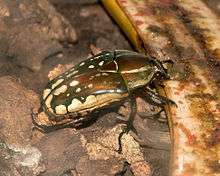Mecynorhina polyphemus
| Mecynorhina polyphemus | |
|---|---|
| | |
| Male | |
 | |
| Female | |
| Scientific classification | |
| Kingdom: | Animalia |
| Phylum: | Arthropoda |
| Class: | Insecta |
| Order: | Coleoptera |
| Family: | Scarabaeidae |
| Genus: | Mecynorhina |
| Species: | M. polyphemus |
| Binomial name | |
| Mecynorhina polyphemus (Johan Christian Fabricius, 1781) | |
Mecynorhina polyphemus is a large scarab beetle of the subfamily Cetoniinae found in dense tropical African forests. It is a frequent feeder on fruits and sap flows from tree wounds. There are several varieties including M. polyphemus polyphemus, M. polyphemus confluens, and M. polyphemus rufuino. [1]
The larvae develop in decomposing log compost. The third instar constructs an ovoid cocoon for metamorphosis and attaches it to a solid surface. In captivity, the instar may attach the cocoon to a glass container wall allowing the opportunity to view the transformation.[1] [2]
Male and female are dimorphic. The female has a shiny surface texture, reflective prismatic coloration, and no horns. The male has horns and flat, velvety coloration.[1] Females are typically 35–55 mm, while males range from 35–80 mm.[3]
Common names include Polyphemus beetle, magnificent flower beetle, giant African fruit beetle.
References
- 1 2 3 "Chelorrhina polyphemus". Retrieved 2010-12-29.
- ↑ "Insect Collection". Retrieved 2010-12-29.
- ↑ "CHELORRHINA". Retrieved 2010-12-29.